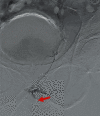Penile Glans Necrosis following Prostatic Artery Embolization for the Treatment of Benign Prostatic Hyperplasia: A Rare but Serious Complication
- PMID: 33791141
- PMCID: PMC7984866
- DOI: 10.1155/2021/6662899
Penile Glans Necrosis following Prostatic Artery Embolization for the Treatment of Benign Prostatic Hyperplasia: A Rare but Serious Complication
Abstract
Background: Prostate artery embolization (PAE) is a novel endovascular procedure to treat men with benign prostatic hyperplasia (BPH) symptoms who wish to maintain sexual potency postoperatively. However, serious treatment-related adverse events (TRAEs) of PAE such as penile glans necrosis (PGN) can be devastating and require urgent attention. Case presentation. Mr GM is a 65-year-old sexually active Anglo-Saxon man who have long-standing BPH symptoms unresponsive to medical therapy. While he had an uneventful bilateral superselective PAE using gel foam, there were signs to suggest of PGN, and this was treated conservatively. The patient presented to the emergency department 5 days later with a painful, dark penile glans and accompanying urinary dysuria and hematuria. Clinical examination confirmed evolving PGN. He received 10 courses of hyperbaric oxygen therapy (HBOT) with complete resolution of his PGN.
Conclusion: While superselective embolization is usually always performed, nontarget embolization may occur, as intravascular particles may reflux into adjacent vessels. In this unique and extremely rare case report of PGN following PAE, complete resolution was achieved with HBOT. Proposed benefits of HBOT include anti-inflammation, promotion of neovascularization, and induced rate of collagen deposition, resulting in a faster and more effective resolution of PGN.
Copyright © 2021 Eric Chung.
Conflict of interest statement
The author(s) declare(s) that they have no conflicts of interest.
Figures
References
-
- Moreira A. M., de Assis A. M., Carnevale F. C., Antunes A. A., Srougi M., Cerri G. G. A review of adverse events related to prostatic artery embolization for treatment of bladder outlet obstruction due to BPH. Cardiovascular and Interventional Radiology. 2017;40(10):1490–1500. doi: 10.1007/s00270-017-1765-3. - DOI - PubMed
Publication types
LinkOut - more resources
Full Text Sources
Other Literature Sources



